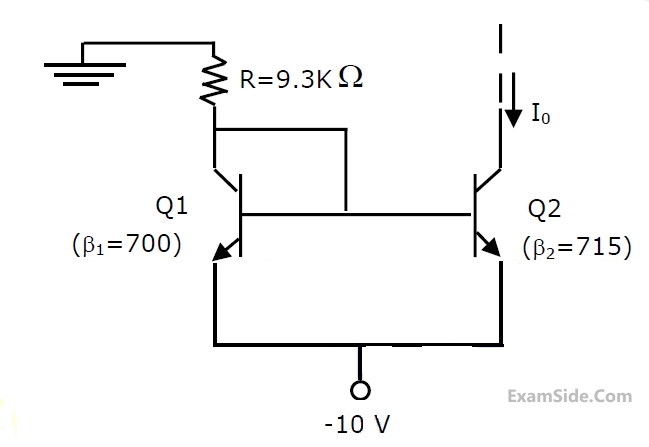1
GATE ECE 2014 Set 2
Numerical
+1
-0
A cascade connection of two voltage amplifiers A1 and A2 is shown in the figure. The open-loop
gain Av0, input resistance Rin, and output resistance R0 for A1 and A2 are as follows:
A1: Av0 = 10,Rin = 10 kΩ ,R0 =1 kΩ
A2 : Av0 = 5,Rin = 5 kΩ , R0 = 200 Ω
The approximate overall voltage gain $$\frac{{\mathrm V}_\mathrm{out}}{{\mathrm V}_\mathrm{in}}$$ is ______.
A1: Av0 = 10,Rin = 10 kΩ ,R0 =1 kΩ
A2 : Av0 = 5,Rin = 5 kΩ , R0 = 200 Ω
The approximate overall voltage gain $$\frac{{\mathrm V}_\mathrm{out}}{{\mathrm V}_\mathrm{in}}$$ is ______.

Your input ____
2
GATE ECE 2012
MCQ (Single Correct Answer)
+1
-0.3
The current ib through the base of a silicon npn transistor is
$$1\;+\;0.1\;\cos\left(10000\;\mathrm\pi\;\mathrm t\right)$$ mA
. At 300 K,
the $$r_\mathrm\pi$$ in the small signal model of the transistor is


3
GATE ECE 2011
MCQ (Single Correct Answer)
+1
-0.3
In the circuit shown below, capacitors C1 and C2 are very large and are shorts at
the input frequency. Vi
is a small signal input. The gain magnitude $$\left|\frac{{\mathrm V}_0}{{\mathrm V}_\mathrm i}\right|$$
at 10 Mrad/s is


4
GATE ECE 2010
MCQ (Single Correct Answer)
+1
-0.3
In the silicon BJT circuit shown below, assume that the emitter area of transistor
Q1 is half that of transistor Q2.The value of current I0 is approximately


Questions Asked from Bipolar Junction Transistor (Marks 1)
Number in Brackets after Paper Indicates No. of Questions
GATE ECE 2025 (2)
GATE ECE 2016 Set 3 (1)
GATE ECE 2016 Set 2 (1)
GATE ECE 2014 Set 4 (1)
GATE ECE 2014 Set 3 (1)
GATE ECE 2014 Set 2 (1)
GATE ECE 2012 (1)
GATE ECE 2011 (1)
GATE ECE 2010 (2)
GATE ECE 2006 (1)
GATE ECE 2005 (1)
GATE ECE 2004 (1)
GATE ECE 2001 (1)
GATE ECE 2000 (1)
GATE ECE 1998 (4)
GATE ECE 1995 (2)
GATE ECE 1994 (2)
GATE ECE 1993 (2)
GATE ECE Subjects
Signals and Systems
Representation of Continuous Time Signal Fourier Series Discrete Time Signal Fourier Series Fourier Transform Discrete Time Signal Z Transform Continuous Time Linear Invariant System Transmission of Signal Through Continuous Time LTI Systems Discrete Time Linear Time Invariant Systems Sampling Continuous Time Signal Laplace Transform Discrete Fourier Transform and Fast Fourier Transform Transmission of Signal Through Discrete Time Lti Systems Miscellaneous Fourier Transform
Network Theory
Control Systems
Digital Circuits
General Aptitude
Electronic Devices and VLSI
Analog Circuits
Engineering Mathematics
Microprocessors
Communications
Electromagnetics